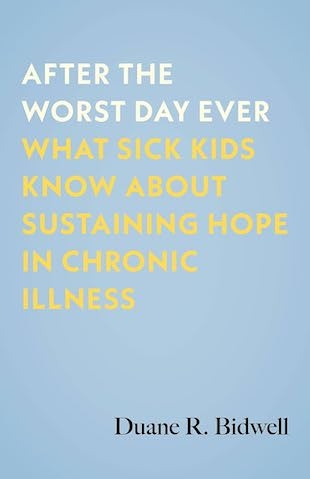Who doesn’t need a book about hope right now? After the Worst Day Ever by Duane R. Bidwell is just that, and well worth a read.
While the subtitle — What Sick Kids Know about Sustaining Hope in Chronic Illness — bespeaks a researcher’s specificity, the book is much more than a resource for caregivers of children with chronic illness. It is a reframing of hope that is much needed for those confronting a world ill with pollution and climate change — which is to say, all of us.
It is also a book that can help people face suffering — “those who are ill and those who will be.” Which is to say, again, all of us.
Bidwell, a trained chaplain and teacher of spiritual care, spent years in dialysis clinics hanging out with kids whose incurable condition and stolen childhood might have decimated their store of hope.
And that might have been what Bidwell saw if these kids had mirrored back to him our default, adult conception of hope, which is “primarily about progress or a better future”: “individualistic, optimistic, temporal, patriarchal, Western, and neoliberal.”
Thankfully, these young folks taught him about their kind of hope, which is “about living well with suffering in the present.” Children with end-stage renal disease, it turns out, access a sense of abundance, “a non-material abundance that surrounds them day by day.” They gain awareness of this abundance through five practices: realizing connections, claiming power, attending to spirit, choosing trust, and maintaining identity.
Within each of these practices, children focus not on the future but on the abundance they find in being present — to life, loved ones, and a sense of purpose. This is the most surprising takeaway from Bidwell’s many conversations with incurably sick kids: for them, “hope . . . belongs to the present rather than the future.” In fact, Bidwell found that, when children talked with him about suffering, a present condition if ever there was one, they did so because suffering was where they accessed hope; sick kids “honor suffering as the crucible for hope.”
Bidwell’s work is rich in the sort of insights you might expect from, say, a work on Buddhist spirituality, but his sacred texts are the clear-eyed observations of suffering children, relayed by an adult with the wisdom to listen deeply. Accordingly, Bidwell gives over much of the book to their stories and interviews, so that the reader gets the benefit of hearing their truths in their own voices. They are, after all, the experts: experts in their own experience, yes, but also experts in that they are free from much of the influence, assumption, and justification that can corrupt educated perspectives.
Sandy Eisenberg Sasso framed childhood similarly in her recent workshop on children’s spirituality. She told a story about a young boy who sneaked into his baby brother’s room and said: “Tell me about God. I’m starting to forget.” Children are born with a deep connection to transcendence and creation that is often trained out of them. After the Worst Day Ever is yet another plea to listen to our young ones and to not confuse youth with unknowing.
Children know things we’ve forgotten. And what they know, brilliantly summarized in the chapter “Learning from Children,” is how to be human when “normal” is disrupted. Their responses to chronic illness can help us as we navigate our own disruptions of “normal” — global pandemics, climate crises, and famine, to name a few.
